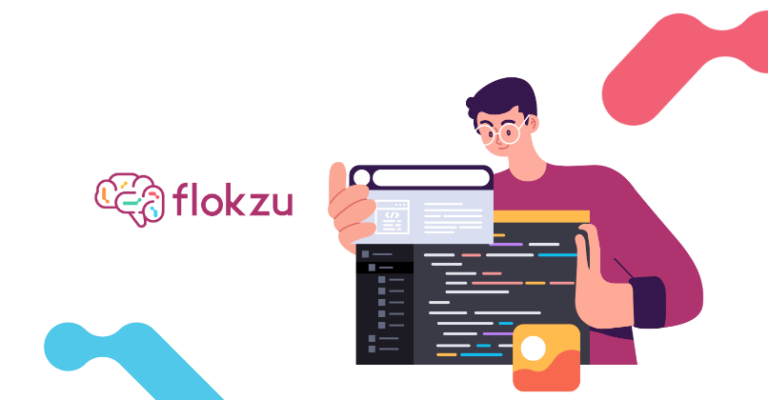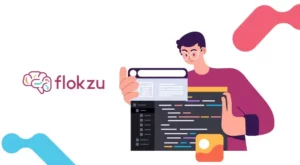A customer’s success in using the products or services we offer must be managed to maximize it (Customer Success). Success is when customers achieve or exceed the results they were looking for when they purchased our products or services. There are several processes for customer success, described in this article with concrete examples and real-life applications. We will also describe the most important performance indicators (KPI’s) to objectively determine if we are managing customer success well.
Customer success is always framed in a relationship with the customer, which can be medium or long term. In other words, the concepts discussed in this article apply to products or services through which a relationship is established with the customer who uses or consumes them.
Naturally, managing the success of the customer using our products or services aims to achieve a decrease in customer churn and to increase the value of each customer (either through more sales, recommendations to other customers or a longer duration of the relationship). This translates into increasing Customer Lifetime Value (CLTV).
Customer life cycle stages
We can distinguish at least three major stages in the life cycle of a customer with our products or services:
- Onboarding: corresponds to the first stage of the customer after they finalized the purchase. Note that this stage does not include the conversion (of the prospect into a paying customer), but begins after the conversion is completed. Onboarding is the stage with the highest risk of the customer getting frustrated and abandoning our product or service. The customer does not yet know our product or service in detail, does not know how to get the most out of it, and does not fully trust our company. Below we will present several processes that help manage these risks and safely navigate this first stage.
- Active customer: this is the stage that lasts the longest, when the customer actively uses our product or service. During this stage we seek to ensure that the product or service is really useful to the customer, and that we can also grow with that customer. In other words, if the customer values our product or service, we will try to materialize that value, either by selling more, getting recommendations, or ensuring that the customer stays with us for a longer period of time.
- Offboarding: unfortunately, customers do not last forever. In the offboarding stage, we must ensure that we end the relationship with the customer in the best possible way. Both so that he can come back in the future, as well as for what he will say about our product, service or company. This being so, it is important to collect everything owed, as well as to terminate all existing agreements, return any information or documentation we may have exchanged, etc.
Customer success processes
For each of the stages of the customer lifecycle described above, there are processes whose execution is key for the customer to be successful using our products and services, achieving the results they sought when purchasing.
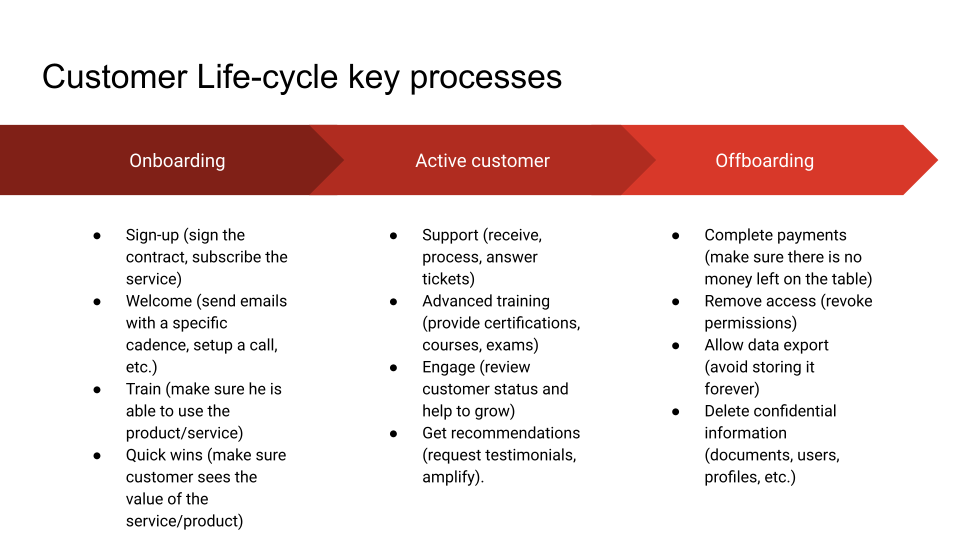
Onboarding stage
In the onboarding stage we can identify – at least – four key processes:
Customer registration: this process can be very simple or complex depending on the type of product or service. It includes the signing of the contract or subscription to the service, the initial configuration of the client (if it is software, for example, the setup of the tool), the delivery of licenses or access codes, etc. It is important that all these tasks are formally modeled in this process, and that an audit trail of their execution is kept. Modeling the process in BPMN notation in Flokzu will help significantly, allowing to see all the tasks to be performed, and their precedences, in a graphical and intuitive model.
Welcome: once the customer is operational, it is important to give him a proper welcome, either through an initial meeting, product or service demonstration, or joint work session. It is also very useful to set up a sequence of emails with a certain cadence, but it is even better if these emails are triggered by events, for example when the user uses a relevant feature of our product or service.
Training: implies making sure that the customer can use the product or service in the right way and achieve the desired results. As an example, in Flokzu there is a free course on Udemy to learn the main concepts of the discipline and the tool. But it could also be direct training to the client (in virtual or face-to-face sessions).
Quick-wins: the aim is for the customer to quickly achieve results that strengthen their decision to purchase our product or service. These achievements also help to convince skeptics, to add them to the use of the product. Eventually, these quick results also allow us to begin to reverse the position of the detractors of our product or service if any.
Active Customer Stage
Once active, we identify – at least – four processes for customer success:
- Support: process by which we receive doubts, problems, complaints from the customer and try to respond to those tickets as accurately and quickly as possible. It is very important that this process is formalized in order to have full traceability on what precisely the customer asked for, what the answer was, when it was given, etc. From these elements it is possible to continuously improve the support process. The Flokzu Process Library includes a template for the customer support process, which includes the following workflow, and which naturally should be adapted to the particular needs of each organization:
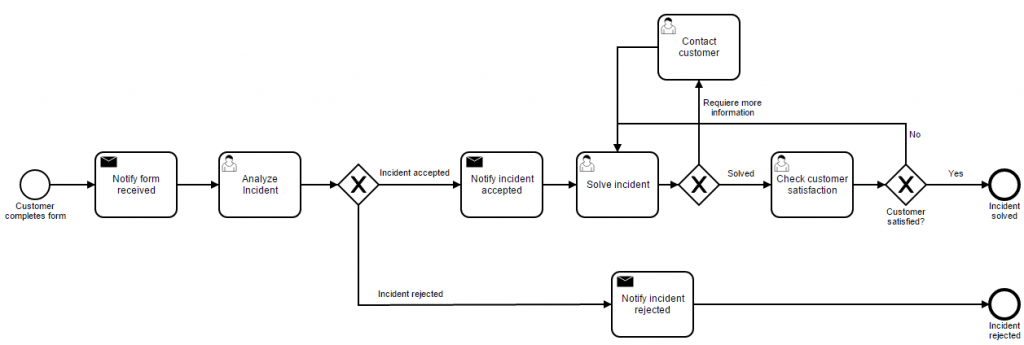
Advanced training, either through advanced courses, skills, and abilities certification programs or other instruments. The objective will always be that the customer can make exhaustive and intensive use of the product or service, to get the most out of it. In these cases, it is important to have a formally modeled process that ensures that all stages are fulfilled, alerts are triggered in case a customer gets stuck at a stage, etc.
Engaged customer. While the customer is actively using our product or service, it is good to have a process that supports growth in that customer. In software solutions, it will be important that the customer acquires more licenses or users. In a service, it will be that the customer uses it more, by more people, or indifferent organizational units. It should not be subject to luck or good memory, there must be a process that supports this growth within each client.
Recommendations. They must be managed: solicited, refined, amplified. In some service areas, recommendations are the most important element to obtain new clients, who previously do not know us, or do not trust us, or both. The recommendation of an acquaintance who successfully uses our products and services becomes a fundamental piece of the commercial puzzle.
Offboarding stage
While not a pleasant stage, it is key among the processes for customer success those that address the event that the customer ceases to be a customer:
- Get Payments. It is important to ensure that the customer fulfills all of their obligations when they stop using our products or services, and in particular with pending payments. This is a common problem, which must be solved, but always with professionalism and objectivity. In this sense, it is advisable to have a formal process for the collection of debts from customers who cease to be customers. This process should have different tasks and alerts to ensure that the steps are carried out in a timely manner. Remember that the older a debt is, the more difficult it is to collect.
- Eliminate access, revoke permissions, terminate the service. A typical mistake, especially when providing unattended services (such as SaaS software), is to forget to revoke all access, permissions and services provided to the departing customer. Flokzu allows you to define this process, which includes a checklist of the accesses to revoke or permissions to remove, and also has an audit of who completed the list. This way we can ensure that the service that the customer will no longer pay for is effectively terminated, and that this is done in an efficient and professional manner.
- Allow data export and avoid storing data with the costs that this implies. This point applies especially to services that store customer data. The customer should always be able to export his data. It is their right. But in addition, it would be a very bad image and experience for the customer if the provider retained his data or tried to use this as an anchor to retain him as a customer. You will not succeed, but you will get a highly dissatisfied customer who will speak very badly about the company, product and service.
- Eliminate confidential information. In cases where there is an agreement that mandates the removal of confidential information held by the parties (e.g., an NDA), there must be a formal and auditable process to ensure that all sensitive information is returned to the other party or properly removed from the logical or physical storage that contained it.
Indicators to measure processes for customer success
The success that the customer has using our products or services is difficult to measure, mainly because it is in practice impossible to access this information directly and objectively. It is not feasible to measure – in the vast majority of cases – how much our customer’s operation or management has improved as a result of using our products or services.
However, we can use indirect performance indicators (KPI’s), which are part of the customer success processes described above, and which help us to have as objective a view as possible of how each of our customers is doing.
There is a wide variety of metrics to measure customer success. In this article, for example, 16 are presented, with different scope and applications. While all are useful, we believe that there are four that are the most important, and that can be grouped into two categories: customer retention and customer satisfaction:
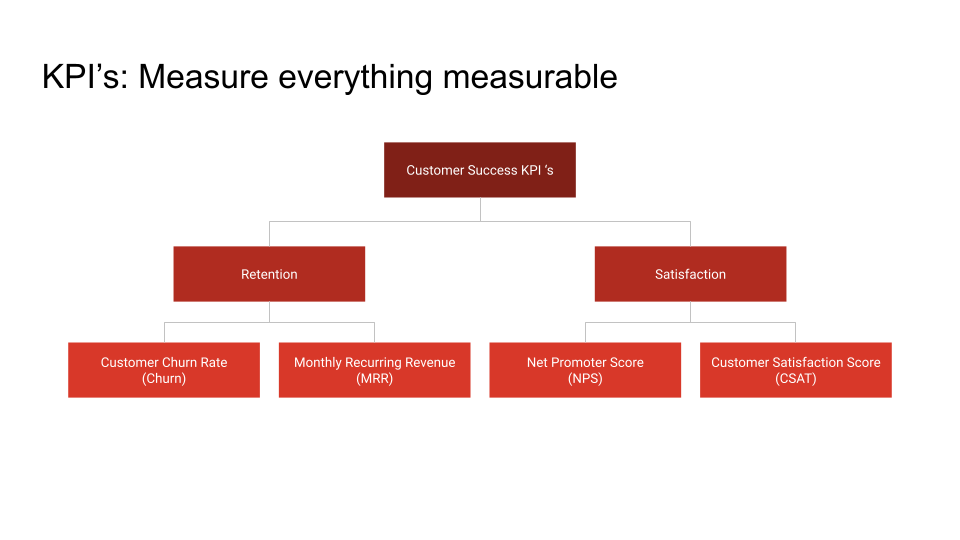
- Retention: Churn rate (Churn) measures how many customers are abandoning our service. Naturally, it is a super important measure, but it is an autopsy. It is measured after the customer has already left. However, it is one of the most important indicators that we should always monitor.
- Retention: Monthly Recurring Revenue (MRR) measures how much the customer is spending each month. This indicator allows us to see if they are spending more, the same or less. It makes sense when compared to previous periods (previous month, previous quarter, previous year). And since he is still a customer, we can act accordingly.
- Satisfaction: Net Promoter Score (NPS) measures the likelihood that a customer will recommend a company, product or service to a friend or colleague. It is a widely used metric because of its simplicity, and because of the effectiveness of the recommendations.
- Satisfaction: Customer Satisfaction Score (CSAT) measures how well products or services meet or exceed customer expectations. As in the previous case, it is an indicator that is taken while the customer is still a customer, so it allows corrective actions if necessary, and long-term improvement plans.
Conclusions
It is possible and highly recommended to define and automate customer success processes that help ensure retention first, and total satisfaction second. When the organization’s operations are small, these processes are carried out naturally and intuitively, but as operations grow, it is essential to formalize them. This ensures that the entire organization uses the same processes, ensuring the desired level of quality. In addition, this allows to measure through KPI’s the result of these processes, to take corrective measures if necessary, and to elaborate long-term plans to maximize the success of the customers using the products and services offered.
With Flokzu BPM it is possible to graphically model all these processes, and then automate them with a click (without programming and in a very short time). Flokzu’s low-code features allow business users (and not necessarily IT users) to define the processes and put them to work autonomously. In this way, it is possible to significantly improve customer success in using the services and products offered in very short timeframes. And most importantly, evolve these processes to meet the new challenges that will certainly appear in the future.
Now that you know all the benefits, we invite you to schedule a meeting with one of our experts, so we can automate together a complete process, and improve your organization.

